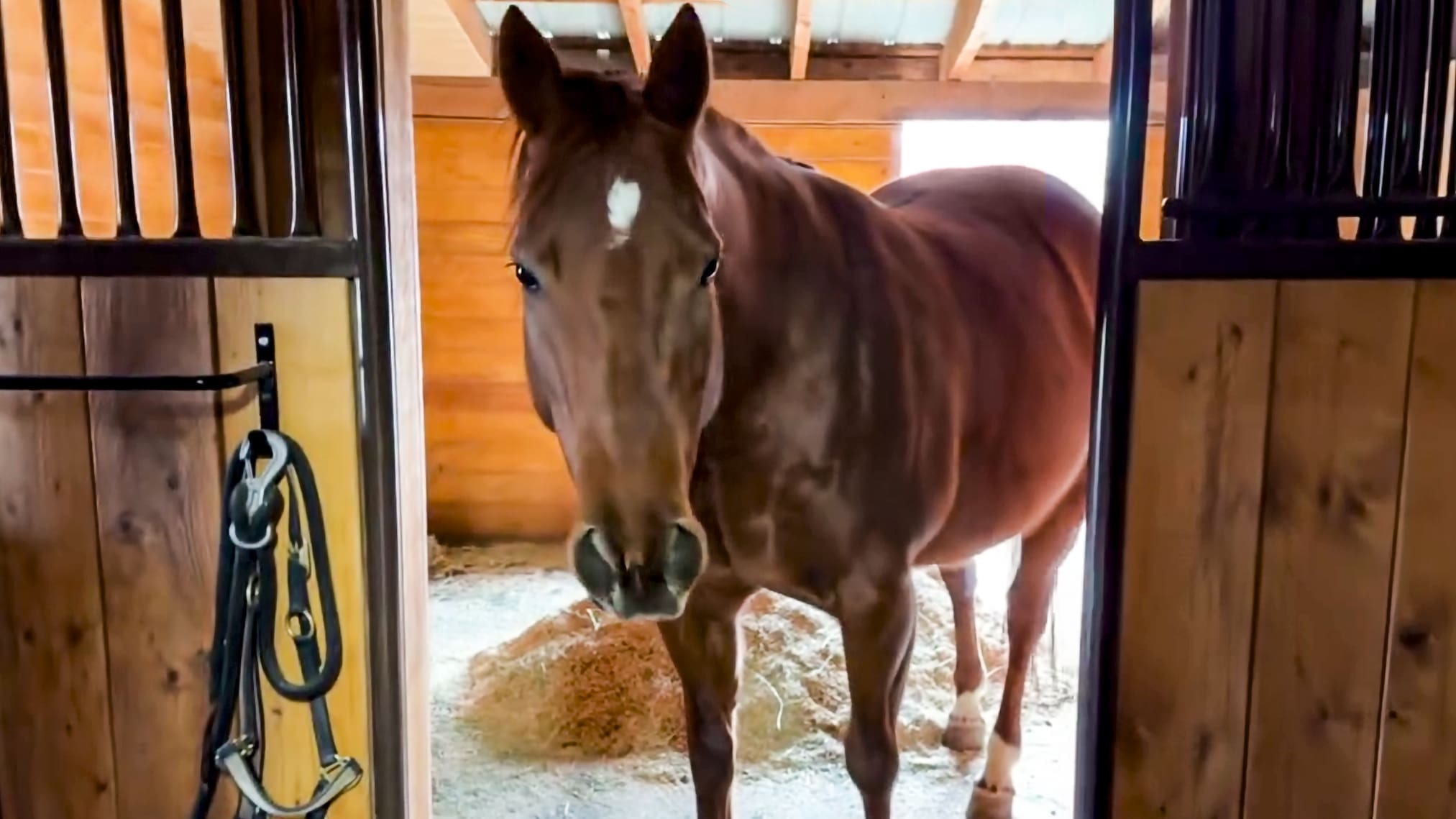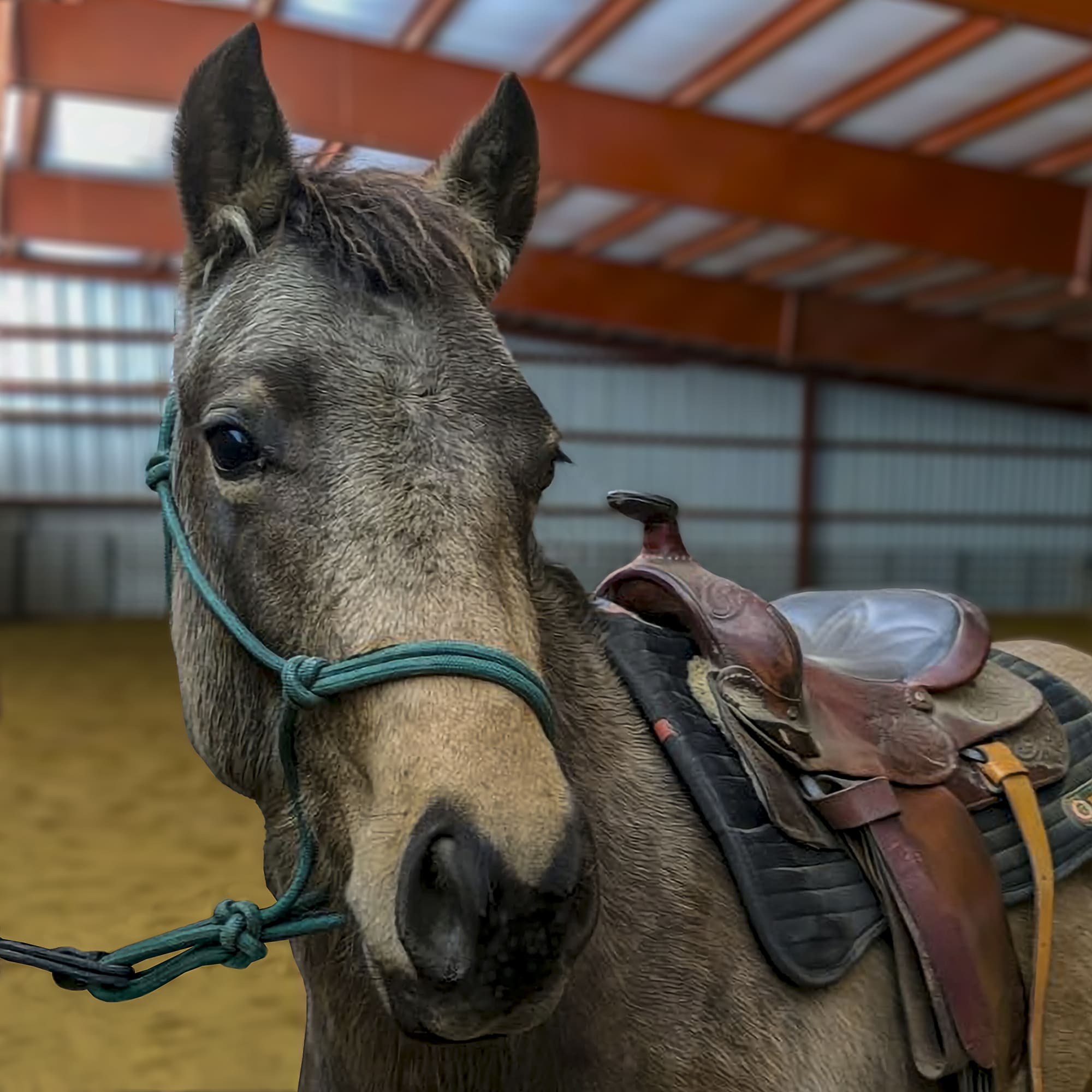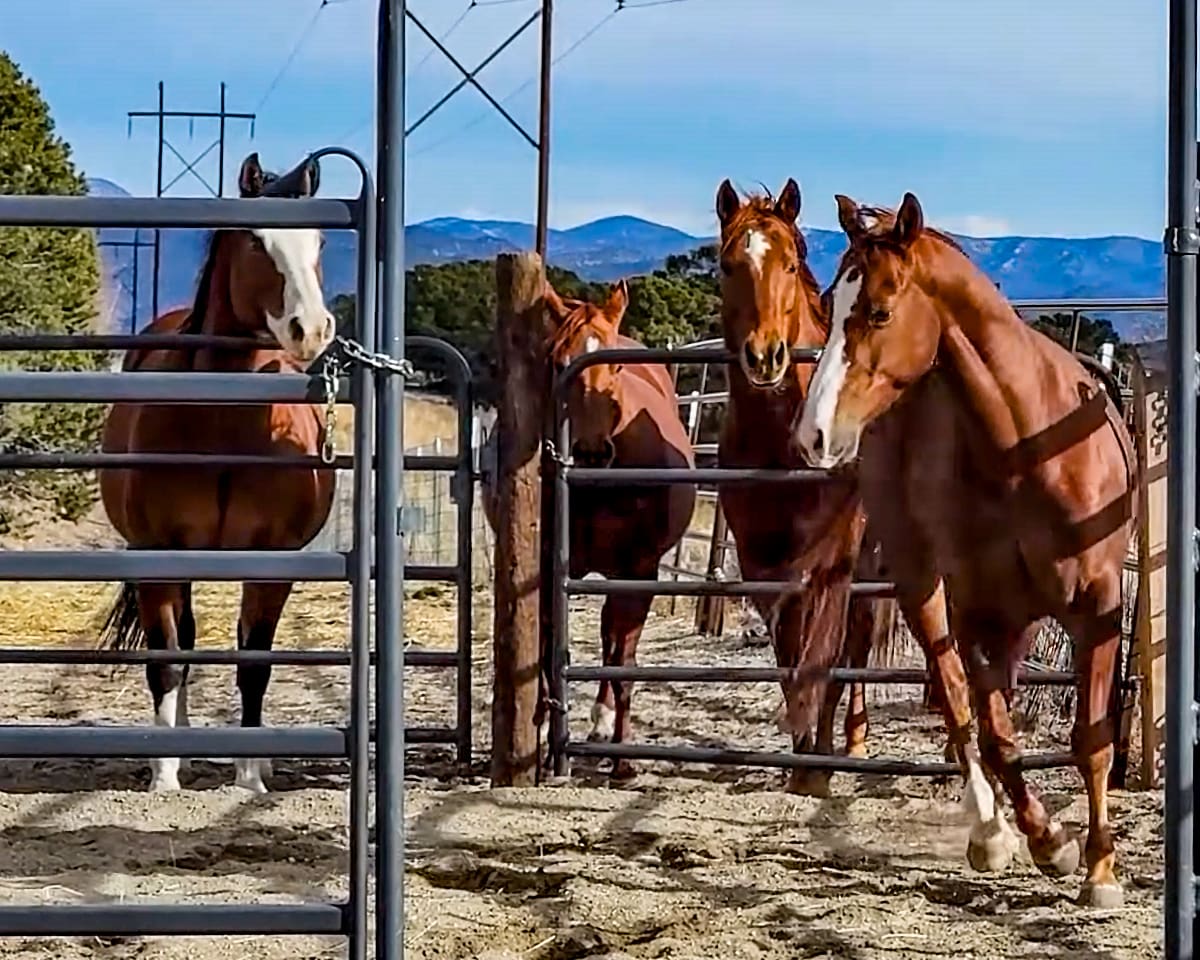Question Category: Issues from the Ground
Question: Hi Julie,
I was at your clinic in Colorado Springs—I don’t know if you’ll remember me, but I had the 4 year old black BLM mustang, Ranger, with whom you worked on “stand still.” He’s the one who laid down for a nap in the arena on the second day. Ranger did GREAT after the clinic, for quite a long time. However, we moved to a new barn in November. Since our move, he’s gone downhill and seems nervous and defensive most of the time.
He won’t stand still more than a few seconds, regardless of how many times I correct him. Standing tied has become a nightmare and a battle, and it’s to the point that I don’t enjoy working with him right now (although I do, because he’s my horse, my responsibility and I love him dearly). I read every related article on your website, and am going to modify a few of the things I still do (kissing him on the nose), but didn’t see anything that addressed this level of disrespect. The tie area is inside and about 20’x20’. He’s tied to a ring on the wall, so can’t see forward. He usually stands with one side against the wall. I tie him with about 12”-18” of line. He will not stand still at all—he slings his body back and forth (usually running me over), slams his head against the wall, paws, tries to “push” through the lead rope, tries to slam his head into me, has started trying to nip when I groom him, etc. He gets so wound up that he’s shaking and sweating—he’s clearly stressed by being tied, but I don’t think that he’s afraid. He has always tied pretty well in the past, but has never stood well—previously he simply moved his body back and forth but the other behaviors are new. This is the first solid wall, though—the others were tie racks, fence posts, etc, so he could see forward. He will pull back, slowly, to find the end of the slack, but doesn’t fight—he usually has slack in the line, but will sometimes lean against it. He doesn’t set back or fight unless he’s truly scared, and when he does, it’s one or two head shakes with a sort of half-rear, then he comes forward to stand. Those events are very rare.
I have tried several things in order to help him understand that he has to stand tied, quietly. I spent days simply asking him to stand quietly without being tied, moving closer to the wall & tie ring. He did pretty well as long as I was on the other end of the line. The minute I tied him, he resorted to these behaviors. When he is tied, I have tried getting “big” and using the end of the lead rope to define my space—he runs through it and slams into me anyway. I now use a dressage whip to ask him to stay off of me, and smack him on his hip or side when he moves towards me, but he runs through that, runs me over, then goes back to his original position. I’m escalating to the point of being worried about hurting him, although I know that I’m probably not big or strong enough to do that. I’ve also used a second lead rope on his halter to correct him (so that he’s tied, but I also have a lead rope) and that helps somewhat, but doesn’t seem to matter when he’s slinging his body back and forth. This has gone on, on a daily basis, for the past two months. I don’t know what else to do. He has also started to yank his foot away and step on me or hop and jump on me when I’m trying to clean his feet. Last week, he tried to pull away from the farrier, then jumped on top of him when he couldn’t pull away (we resorted to a stud chain at that point—his first time with one, because he’s always been pretty good, but I can’t let him hurt someone. He did behave very well with the stud chain—I don’t blame him because I know that it hurts.)
When he does stand still, I praise him, rub his withers or neck, or scratch his butt and step away for a second, but then he tries to move towards me and starts pawing frantically. It’s as though he can’t stand not to have me near him, but doesn’t want me near him at the same time.
The barn managers really get after him, much harder than I do, with the lunge whip when he moves. This doesn’t seem to help at all. One is a quiet man, who is firm and clear, but the woman is loud and much harder, so there’s not a lot of consistency between them. I will say that their horses are very well behaved and stand very quietly when tied. They have trained horses for over 30 years, each. Anyway, she thinks that I need to tie him all day, for as many days as it takes, as short as I can until he works through the fact that he’s tied. The barn manager thinks that I need to tie one leg up, particularly after he yanks a leg away when I’m cleaning his feet, to teach him a lesson. Again, I don’t see how this teaches him anything, particularly since there isn’t a release until we get around to untying his leg—and if he panics and falls, he could break his leg or his neck.
He doesn’t do this body stuff when he’s on the lunge line or lead line. His whoa is terrific although his “stand still” has degraded. I continue to work on it as much as I can. Some days, that’s all we do—stand with the goal of standing for 30 seconds. He’s also not standing under saddle at all—the barn manager says that he’s just not tired and I should work him until he’s ready to drop, and Bill Dorrance’s book says that horses like him need a job and need to be moved before it’s their idea, and eventually they’ll understand that standing still is OK. Ranger, at this point, seems to think that standing is the worst punishment ever—no matter how much we work on the lunge line (start, stop, turn, turn again, work hard, disengage, etc), standing still isn’t a reward. Julie, he will back himself around the arena just to avoid standing still because he knows that, when he moves, he gets backed (when he starts backing, I “help” him, then we disengage a lot, then try standing again).
The most ironic thing is, when I free-lunge him then ask him to join up, he will stand still beside me, head down, and not move until I ask him to move. I can pick up his feet, clean his sheath, do whatever, and it’s as though he’s dead broke and 25 years old—but only when he doesn’t have a halter on. We’ve been able to stand quietly while I putter around him for up to an hour, without anything more than a shift in weight. Probably not the smartest or safest way to clean feet and sheath, but thus far, it’s the only way I can do it without a fight. When he’s totally unfettered, he behaves the way I’d like him to behave when he’s tied. It seems as though everything starts going wrong when the halter is put on, and it’s downhill from there. Do you have any ideas that might help me? I love my horse and want him to be a good citizen, and we will both be much happier when I learn how to assert my leadership and he submits. I just don’t know where I’m going wrong at this point, or whether I should let the barn manager up the ante, or what. I suspect that there’s a battle for leadership going on, a lack of obedience, understanding & training on his part, and a lack of knowledge on my part. I think that there has been an erosion of trust due to the battles that we’ve been having, too.
I don’t think he has pain issues as the root of this—I had a chiropractor adjust him about a week ago (his shoulder was a little out, but not badly, and there were no other sore spots). His teeth were floated about 6 months ago and his jaw moves freely, so I don’t think that he has teeth issues.
I’m hoping to ride again at your August clinic, if I can get the days off, and I hope at that point all we’re working on is “smoother lead changes” or “better trot transitions” or something like that! Thanks, Julie, for any words of wisdom you might have.
Karen and Ranger
Answer: Karen,
The behaviors you describe are certainly very extreme and it seems like these issues are a result of your horse having a volatile and temperamental disposition and his being a BLM Mustang. BLM Mustangs are wild horses that have been brought into captivity; thus making them potentially much different animals than their domesticated cousins. Not all Mustangs take well to domestication and confinement and taking away the horse’s ability to flee and putting him in a cave where he cannot see or hear potential threats, may be too much for some Mustangs. I would back up and try to work with him in a situation that is more reasonable for him, like being tied outside. I would also continue to do as much work as possible with him at liberty so that he knows the way you want and expect him to act. Then add a halter, but ground tie, and gradually work up to tying him, starting with tying him in the easiest place (outside).
Your horse is employing full-blown temper tantrums and once he has crossed that threshold, training and reasoning with him will not work. I have worked with other horses that have similar tempers and I have learned that you cannot fight fire with fire. Harsh treatment, whipping, tying up legs, etc., will only fuel his anger and validate his desire to fight or flee. Whipping a horse to make him stand still is not logical and will never work. I have seen some incredibly brutal techniques employed in situations like this but I have never seen them work.
Although I am a big fan of the ‘patience post’ (letting horses stand tied for hours on end), in this circumstance, I am not sure that will work. I have seen tantrumming horses go on for days, at great physical detriment to themselves. Eventually they break down physically out of exhaustion, but once they regain their strength, they revert to their former ways. Training will not occur unless a horse is thinking and in the midst of a severe emotional episode like you describe, there is no thinking going on, only instinctive fight or flight response. Back up and work on smaller goals with this horse. Try to recreate the previous situations under which you were making progress with the horse. Use ground tying and/or liberty work as much as you need to help re-establish a norm of behavior. I do think there have been some mistakes made in timing and judgment that have exacerbated your problem, but without witnessing them, it is hard to say what must change.
Good luck and I hope to see you at another clinic this year.
JG
Copyright ©Julie Goodnight 2000. All Rights Reserved. No part of this website may be reproduced without owner’s express consent.




No comment yet, add your voice below!